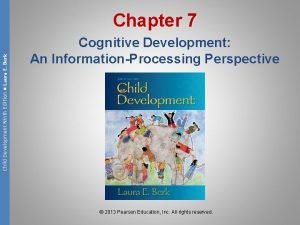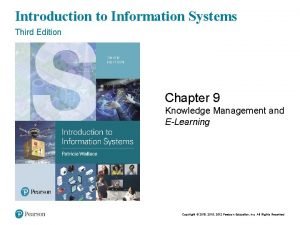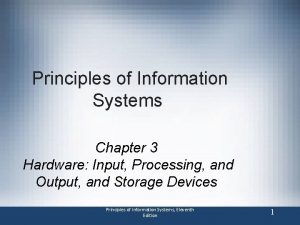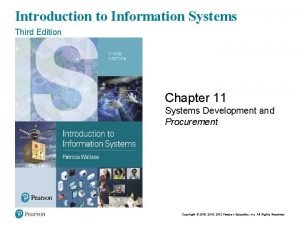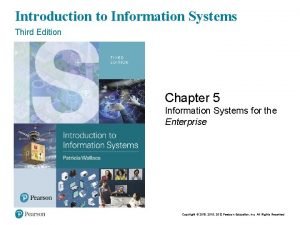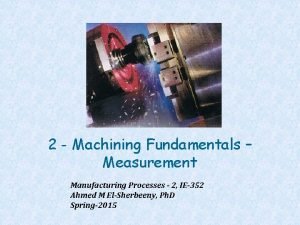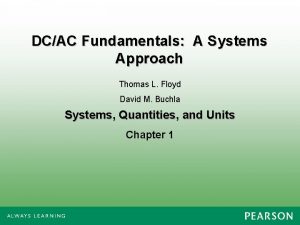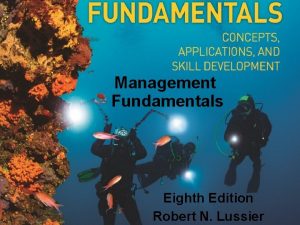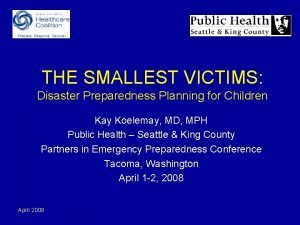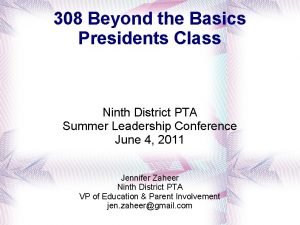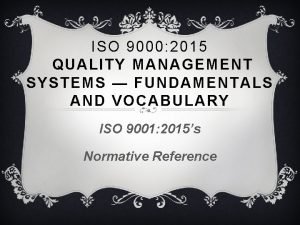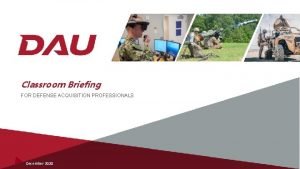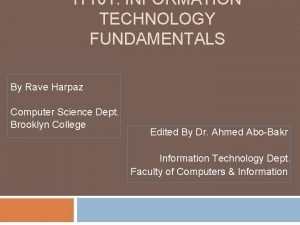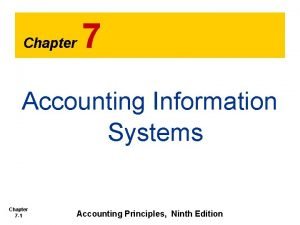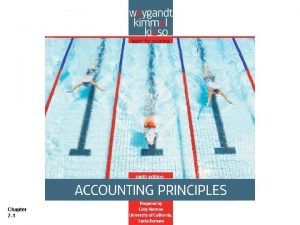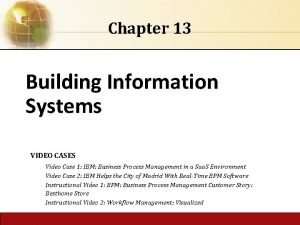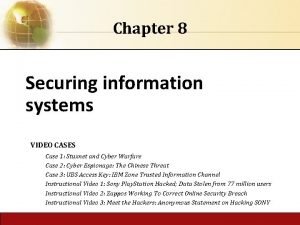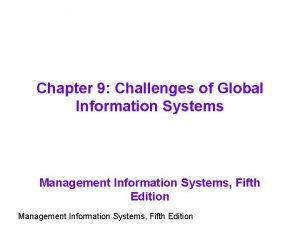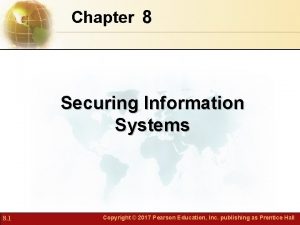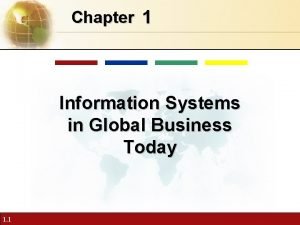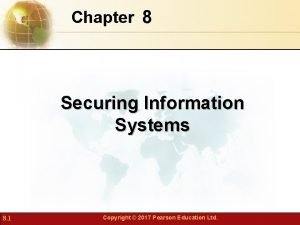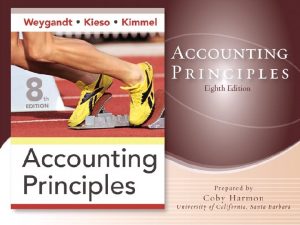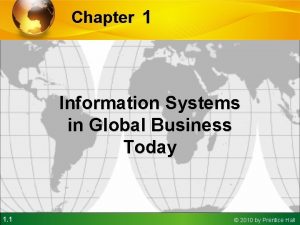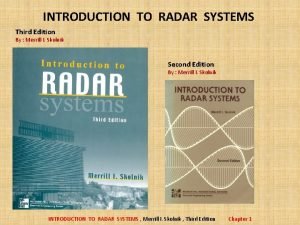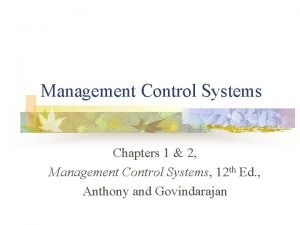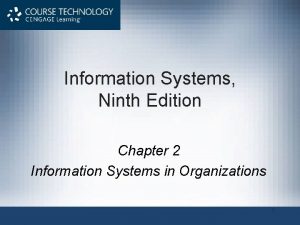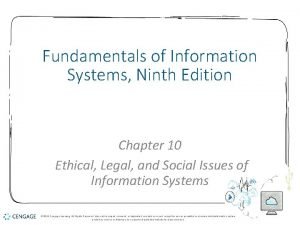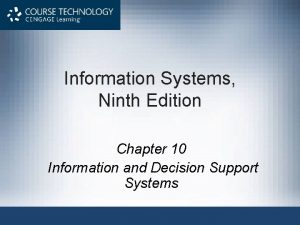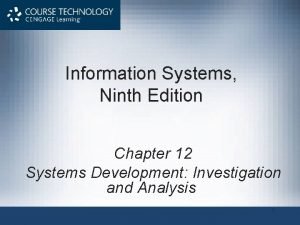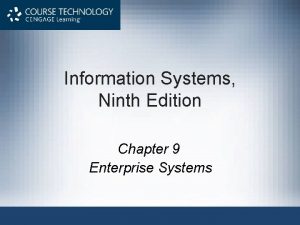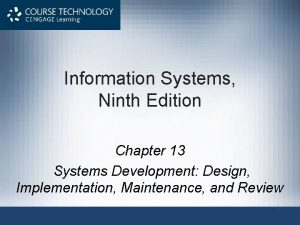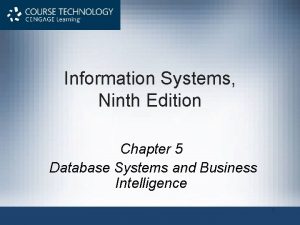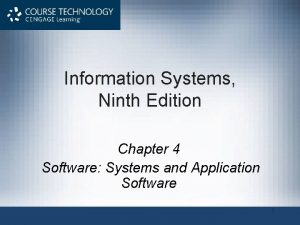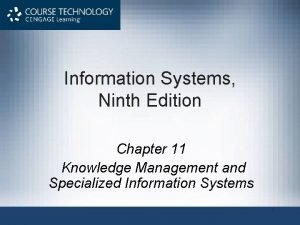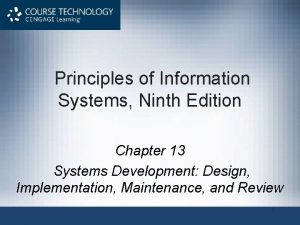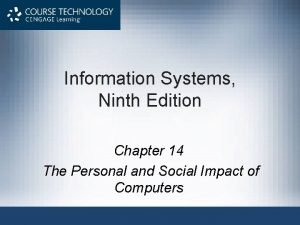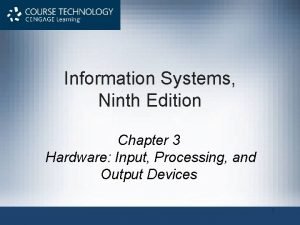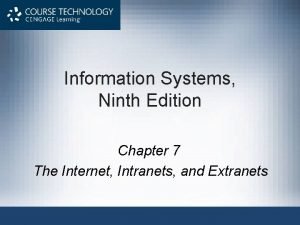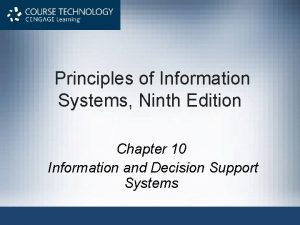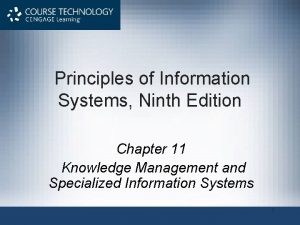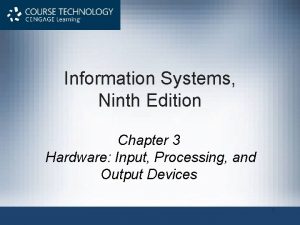Fundamentals of Information Systems Ninth Edition Chapter 5













































































- Slides: 77

Fundamentals of Information Systems, Ninth Edition Chapter 5 Electronic Commerce and Enterprise Systems © 2018 Cengage Learning. All Rights Reserved. May not be copied, scanned, or duplicated, in whole or in part, except for use as permitted in a license distributed with a certain product or service or otherwise on a password-protected website for classroom use. 1

Objectives After completing this chapter, you will be able to: Describe the current status of various forms of e-commerce, including B 2 B, B 2 C, C 2 C, e-government, and m-commerce Identify several advantages and challenges associated with ecommerce and m-commerce Identify and briefly describe several current e-commerce applications Identify the key components of technology infrastructure that must be in place for e-commerce and m-commerce to work © 2018 Cengage Learning. All Rights Reserved. May not be copied, scanned, or duplicated, in whole or in part, except for use as permitted in a license distributed with a certain product or service or otherwise on a password-protected website for classroom use.

Objectives After completing this chapter, you will be able to (cont’d): Discuss the key features of the electronic payment systems needed to support e-commerce and m-commerce Identify the basic activities and business objectives common to all transaction processing systems. Describe the transaction processing systems associated with the order processing, purchasing, and accounting business functions Identify the basic functions performed and the benefits derived from the implementation of an enterprise resource planning system, customer resource management, and product lifecycle management system © 2018 Cengage Learning. All Rights Reserved. May not be copied, scanned, or duplicated, in whole or in part, except for use as permitted in a license distributed with a certain product or service or otherwise on a password-protected website for classroom use.

Objectives After completing this chapter, you will be able to (cont’d): Describe the hosted software model for enterprise systems and explain why this approach is so appealing to SMEs Identify the challenges that organizations face in planning, building, and operating their enterprise systems Identify tips for avoiding many of the common causes for failed enterprise system implementations © 2018 Cengage Learning. All Rights Reserved. May not be copied, scanned, or duplicated, in whole or in part, except for use as permitted in a license distributed with a certain product or service or otherwise on a password-protected website for classroom use.

An Introduction to Electronic Computers • Electronic commerce: conducting business activities electronically over computer networks • Business activities that are strong candidates for conversion to e-commerce are: • Paper based • Time-consuming • Inconvenient for customers © 2018 Cengage Learning. All Rights Reserved. May not be copied, scanned, or duplicated, in whole or in part, except for use as permitted in a license distributed with a certain product or service or otherwise on a password-protected website for classroom use. 5

Business-to-Business E-Commerce • B 2 B e-commerce is a subset of e-commerce • All the participants are organizations • Useful tool for connecting business partners in a virtual supply chain to cut resupply times and reduce costs • Many organizations use both: • Buy-side e-commerce to purchase goods and services from suppliers • Sell-side e-commerce to sell products to their customers © 2018 Cengage Learning. All Rights Reserved. May not be copied, scanned, or duplicated, in whole or in part, except for use as permitted in a license distributed with a certain product or service or otherwise on a password-protected website for classroom use. 6

Business-to-Consumer E-Commerce • B 2 C e-commerce • Customers deal directly with an organization and avoid intermediaries; this is called disintermediation • Reasons for steady growth • Cheaper goods and services via the Web • Online shoppers can design a personalized product • The use of social media networks to promote products and reach customers © 2018 Cengage Learning. All Rights Reserved. May not be copied, scanned, or duplicated, in whole or in part, except for use as permitted in a license distributed with a certain product or service or otherwise on a password-protected website for classroom use. 7

Business-to-Consumer E-Commerce © 2018 Cengage Learning. All Rights Reserved. May not be copied, scanned, or duplicated, in whole or in part, except for use as permitted in a license distributed with a certain product or service or otherwise on a password-protected website for classroom use. 8

Consumer-to-Consumer E-Commerce • C 2 C e-commerce • Involves electronic transactions between consumers are facilitated by a third party • Popular sites include: • e. Bay, Bidz. com, Craigslist, e. Bid, Etsy, Fiverr, Ibidfree, Kijiji, Ubid, and Taobao • Companies and individuals involved in C 2 C must be careful • Sales must not violate the rules of various county, state, and country legal jurisdictions © 2018 Cengage Learning. All Rights Reserved. May not be copied, scanned, or duplicated, in whole or in part, except for use as permitted in a license distributed with a certain product or service or otherwise on a password-protected website for classroom use. 9

Consumer-to-Consumer E-Commerce © 2018 Cengage Learning. All Rights Reserved. May not be copied, scanned, or duplicated, in whole or in part, except for use as permitted in a license distributed with a certain product or service or otherwise on a password-protected website for classroom use. 10

E-Government • E-government is the use of information and communications technology to: • Simplify the sharing of information • Speed formerly paper-based processes • Improve the relationship between citizens and government • Forms of e-Government: • Government-to-consumer (G 2 C) • Government-to-business (G 2 B) • Government-to-government (G 2 G) © 2018 Cengage Learning. All Rights Reserved. May not be copied, scanned, or duplicated, in whole or in part, except for use as permitted in a license distributed with a certain product or service or otherwise on a password-protected website for classroom use. 11

Mobile Commerce • Mobile commerce (m-commerce) relies on the use of wireless devices • The Internet Corporation for Assigned Names and Numbers (ICANN): • Created a. mobi domain to help attract mobile users to the Web • The market for m-commerce in North America • Maturing much later than in Western Europe and Japan • Worldwide, m-commerce accounted for 35 percent of all retail e-commerce sales in the fourth quarter of 2015 • The number of mobile Web sites worldwide is growing rapidly • Because of advances in wireless broadband technologies © 2018 Cengage Learning. All Rights Reserved. May not be copied, scanned, or duplicated, in whole or in part, except for use as permitted in a license distributed with a certain product or service or otherwise on a password-protected website for classroom use. 12

Advantages of Electronic and Mobile Commerce • Reach new customers • Reduce the cost of doing business • Speed the flow of goods and information • Increase the accuracy of order-processing • Improve the level of customer service © 2018 Cengage Learning. All Rights Reserved. May not be copied, scanned, or duplicated, in whole or in part, except for use as permitted in a license distributed with a certain product or service or otherwise on a password-protected website for classroom use. 13

E-Commerce Challenges • Dealing with Consumer Privacy Concerns • About one-third of all adult Internet users will not buy online due to privacy concerns • Overcoming Consumers’ Lack of Trust • In online sellers • Overcoming Global Issues • Cultural, language, time and distance, infrastructure, currency, and legal challenges © 2018 Cengage Learning. All Rights Reserved. May not be copied, scanned, or duplicated, in whole or in part, except for use as permitted in a license distributed with a certain product or service or otherwise on a password-protected website for classroom use. 14

Electronic and Mobile Commerce Applications • Areas in which applications are used • • • Retail and wholesale – Manufacturing Marketing – Advertising Bartering – Retargeting Price comparison – Couponing Investment and finance – Banking © 2018 Cengage Learning. All Rights Reserved. May not be copied, scanned, or duplicated, in whole or in part, except for use as permitted in a license distributed with a certain product or service or otherwise on a password-protected website for classroom use. 15

Manufacturing • Electronic exchange: an electronic forum where manufacturers, suppliers, and competitors buy and sell goods, trade market information, and run back-office operations • Private exchanges are owned and operated by a single company • Consortium-operated exchanges are run by a group of traditionally competing companies with common procurement needs • Independent exchanges are open to any set of buyers and sellers within a given market © 2018 Cengage Learning. All Rights Reserved. May not be copied, scanned, or duplicated, in whole or in part, except for use as permitted in a license distributed with a certain product or service or otherwise on a password-protected website for classroom use. 16

Manufacturing © 2018 Cengage Learning. All Rights Reserved. May not be copied, scanned, or duplicated, in whole or in part, except for use as permitted in a license distributed with a certain product or service or otherwise on a password-protected website for classroom use. 17

Marketing • Market segmentation: the identification of specific markets to target them with advertising messages • Divides the pool of potential customers into subgroups usually defined in terms of demographic characteristics • e. Xelate (a subsidiary of Nielson) • Provides data as a service solution that customers can use to access a database of more than 250 million business records © 2018 Cengage Learning. All Rights Reserved. May not be copied, scanned, or duplicated, in whole or in part, except for use as permitted in a license distributed with a certain product or service or otherwise on a password-protected website for classroom use. 18

Advertising • Methods of buying mobile ad impressions • Cost per thousand (CPM) • Cost per click (CPC) • Cost per action (CPA) • Three main measures of success • Number of users reached • Click through rate (CTR) • Number of actions users take © 2018 Cengage Learning. All Rights Reserved. May not be copied, scanned, or duplicated, in whole or in part, except for use as permitted in a license distributed with a certain product or service or otherwise on a password-protected website for classroom use. 19

Bartering • With economic downturn, many people and businesses have turned to bartering to gain goods and services • A number of Web sites have been created to support bartering © 2018 Cengage Learning. All Rights Reserved. May not be copied, scanned, or duplicated, in whole or in part, except for use as permitted in a license distributed with a certain product or service or otherwise on a password-protected website for classroom use. 20

Retargeting • An average of 74 percent of all online shopping carts are abandoned • Retargeting is used by advertisers to recapture those shoppers by using targeted and personalized ads to direct shoppers back to a retailer’s site © 2018 Cengage Learning. All Rights Reserved. May not be copied, scanned, or duplicated, in whole or in part, except for use as permitted in a license distributed with a certain product or service or otherwise on a password-protected website for classroom use. 21

Price Comparison • Mobile phone apps enable shoppers to compare prices and products online • In some cases, shopper can simply scan an item’s barcode or snap a photo of the item © 2018 Cengage Learning. All Rights Reserved. May not be copied, scanned, or duplicated, in whole or in part, except for use as permitted in a license distributed with a certain product or service or otherwise on a password-protected website for classroom use. 22

Couponing • In 2015, over $515 billion in consumer incentives were distributed in North America • Less than one percent were redeemed • Shoppers can subscribe to mobile coupon aggregators • Mobile coupon redemption rate is expected to increase due to coupon integration in social networks © 2018 Cengage Learning. All Rights Reserved. May not be copied, scanned, or duplicated, in whole or in part, except for use as permitted in a license distributed with a certain product or service or otherwise on a password-protected website for classroom use. 23

Investment and Finance • The Internet has revolutionized the world of investment and finance • The brokerage business adapted to the Internet faster than any other arm of finance © 2018 Cengage Learning. All Rights Reserved. May not be copied, scanned, or duplicated, in whole or in part, except for use as permitted in a license distributed with a certain product or service or otherwise on a password-protected website for classroom use. 24

Banking • Online banking customers can: • Check balances of their savings, checking, and loan accounts • Transfer money among accounts • Pay their bills • Many banks enable customers to perform online banking activities via mobile phone © 2018 Cengage Learning. All Rights Reserved. May not be copied, scanned, or duplicated, in whole or in part, except for use as permitted in a license distributed with a certain product or service or otherwise on a password-protected website for classroom use. 25

Technology Infrastructure Required to Support E-Commerce and MCommerce • Poor Web site performance drives consumers to abandon some e-commerce sites in favor of those with better, more reliable performance © 2018 Cengage Learning. All Rights Reserved. May not be copied, scanned, or duplicated, in whole or in part, except for use as permitted in a license distributed with a certain product or service or otherwise on a password-protected website for classroom use. 26

Hardware • The Web server’s required storage capacity and computing power depend on: • The software that must run on the server • Volume of e-commerce transactions that must be processed • Successful e-commerce solutions are designed to be highly scalable • Can be upgraded to meet unexpected user traffic © 2018 Cengage Learning. All Rights Reserved. May not be copied, scanned, or duplicated, in whole or in part, except for use as permitted in a license distributed with a certain product or service or otherwise on a password-protected website for classroom use. 27

Hardware • Key Web site performance measures • Response time • Transaction success rate • System availability • Key decision for a new e-commerce company • Choosing whether to host its own Web site or to enlist a third-party Web service provider © 2018 Cengage Learning. All Rights Reserved. May not be copied, scanned, or duplicated, in whole or in part, except for use as permitted in a license distributed with a certain product or service or otherwise on a password-protected website for classroom use. 28

Hardware © 2018 Cengage Learning. All Rights Reserved. May not be copied, scanned, or duplicated, in whole or in part, except for use as permitted in a license distributed with a certain product or service or otherwise on a password-protected website for classroom use. 29

Web Server Software • Fundamental services needed in Web server software • • • Security and identification Retrieving and sending Web pages Web site tracking Web site development Web page development © 2018 Cengage Learning. All Rights Reserved. May not be copied, scanned, or duplicated, in whole or in part, except for use as permitted in a license distributed with a certain product or service or otherwise on a password-protected website for classroom use. 30

E-Commerce Software • Five core tasks that must be supported by e-commerce software • • • Catalog management Product configuration Shopping cart facilities E-commerce transaction processing Web traffic data analysis © 2018 Cengage Learning. All Rights Reserved. May not be copied, scanned, or duplicated, in whole or in part, except for use as permitted in a license distributed with a certain product or service or otherwise on a password-protected website for classroom use. 31

Mobile Commerce Hardware and Software • Limitations of handheld devices that complicate their use: • • Screens are small Input capabilities are limited to a few buttons Less processing power and less bandwidth than desktop or laptop computers Operate on limited-life batteries • For these reasons • Web developers must often rewrite Web applications so users with mobile devices can access them © 2018 Cengage Learning. All Rights Reserved. May not be copied, scanned, or duplicated, in whole or in part, except for use as permitted in a license distributed with a certain product or service or otherwise on a password-protected website for classroom use. 32

Electric Payment Systems • Authentication technologies are used by many organizations to confirm the identity of a user requesting access to information or assets • Digital certificate: an attachment to an e-mail message or data embedded in a Web site that verifies the identity of a sender or Web site • Certificate authority (CA): a trusted third-party organization or company that issues digital certificates © 2018 Cengage Learning. All Rights Reserved. May not be copied, scanned, or duplicated, in whole or in part, except for use as permitted in a license distributed with a certain product or service or otherwise on a password-protected website for classroom use. 33

Electric Payment Systems • Various measures are being implemented to increase the security associated with the use of credit cards • Address Verification System is a check built into the payment authorization request - Compares the address on file with the address provided by the cardholder • Card Verification Number - A check of the additional digits typically printed on the back of the card © 2018 Cengage Learning. All Rights Reserved. May not be copied, scanned, or duplicated, in whole or in part, except for use as permitted in a license distributed with a certain product or service or otherwise on a password-protected website for classroom use. 34

Electric Payment Systems • Transport Layer Security (TLS) is a communications protocol used to secure sensitive data during e-commerce • Electronic cash: an amount of money that is computerized, stored, and used as cash for e-commerce transactions • Credit, charge, debit, and smart cards are payment systems used for ecommerce © 2018 Cengage Learning. All Rights Reserved. May not be copied, scanned, or duplicated, in whole or in part, except for use as permitted in a license distributed with a certain product or service or otherwise on a password-protected website for classroom use. 35

Electric Payment Systems © 2018 Cengage Learning. All Rights Reserved. May not be copied, scanned, or duplicated, in whole or in part, except for use as permitted in a license distributed with a certain product or service or otherwise on a password-protected website for classroom use. 36

Transaction Processing Systems • Transaction processing systems (TPSs): • Capture and process detailed data necessary to update the organization’s records about fundamental business operations • Include order entry, inventory control, payroll, accounts payable, accounts receivable, general ledger, etc. • A TPS provides valuable input to: • Management information systems • Decision support systems • Knowledge management systems © 2018 Cengage Learning. All Rights Reserved. May not be copied, scanned, or duplicated, in whole or in part, except for use as permitted in a license distributed with a certain product or service or otherwise on a password-protected website for classroom use. 37

Traditional Transaction Processing Methods and Objectives • Batch processing system • Business transactions are accumulated over a period of time and prepared for processing as a single unit or batch • Essential characteristic: the delay between an event and the processing of the related transaction to update the organization’s records • Online transaction processing (OLTP) • Data processing in which each transaction is processed immediately • At any time, the data in an online system reflects the current status • Many organizations find that OLTP enables them to provide faster, more efficient service © 2018 Cengage Learning. All Rights Reserved. May not be copied, scanned, or duplicated, in whole or in part, except for use as permitted in a license distributed with a certain product or service or otherwise on a password-protected website for classroom use. 38

Traditional Transaction Processing Methods and Objectives © 2018 Cengage Learning. All Rights Reserved. May not be copied, scanned, or duplicated, in whole or in part, except for use as permitted in a license distributed with a certain product or service or otherwise on a password-protected website for classroom use. 39

Traditional Transaction Processing Methods and Objectives © 2018 Cengage Learning. All Rights Reserved. May not be copied, scanned, or duplicated, in whole or in part, except for use as permitted in a license distributed with a certain product or service or otherwise on a password-protected website for classroom use. 40

Traditional Transaction Processing Methods and Objectives • Organizations expect their TPSs to: • • Capture, process, and update databases Ensure that the data is processed accurately and completely Avoid processing fraudulent transactions Produce timely user responses and reports Reduce clerical and other labor requirements Help improve customer service Achieve competitive advantage © 2018 Cengage Learning. All Rights Reserved. May not be copied, scanned, or duplicated, in whole or in part, except for use as permitted in a license distributed with a certain product or service or otherwise on a password-protected website for classroom use. 41

Traditional Transaction Processing Methods and Objectives • A TPS includes: • Order processing systems - Processing flow begins with receipt of customer order, then finished product inventory is checked to see if sufficient inventory is on hand to fill the order - Product pick list is printed at the warehouse and inventory is adjusted - Customer invoice is created and copy included in the customer shipment • Accounting systems - Must track the flow of data related to all the cash follows that affect the organization • Purchasing systems - Systems that support the purchasing business function - Inventory control, purchase order processing, receiving, and accounts payable © 2018 Cengage Learning. All Rights Reserved. May not be copied, scanned, or duplicated, in whole or in part, except for use as permitted in a license distributed with a certain product or service or otherwise on a password-protected website for classroom use. 42

Traditional Transaction Processing Methods and Objectives © 2018 Cengage Learning. All Rights Reserved. May not be copied, scanned, or duplicated, in whole or in part, except for use as permitted in a license distributed with a certain product or service or otherwise on a password-protected website for classroom use. 43

Transaction Processing Systems for Entrepreneurs and Small and Medium-Sized Enterprises • Many software packages: • Provide integrated transaction processing system solutions for small and medium-size enterprises (SMEs) • Are easy to install and operate with a low total cost of ownership • Have an initial cost of a few hundred to a few thousand dollars © 2018 Cengage Learning. All Rights Reserved. May not be copied, scanned, or duplicated, in whole or in part, except for use as permitted in a license distributed with a certain product or service or otherwise on a password-protected website for classroom use. 44

Transaction Processing Activities • The transaction processing cycle • • • Data collection Data editing Data correction Data manipulation Data storage Document production © 2018 Cengage Learning. All Rights Reserved. May not be copied, scanned, or duplicated, in whole or in part, except for use as permitted in a license distributed with a certain product or service or otherwise on a password-protected website for classroom use. 45

Data Collection • Capturing and gathering all data necessary to complete the processing of transactions • Data collection can be: • Manual • Automated via special input devices • Source data automation • Involves capturing data at its source and recording it accurately in a timely fashion with minimal manual effort and in an electronic or digital form so that it can be directly entered into the computer • Example: a scanner reading a UPC code • Cloud-based POS systems provide a range of capabilities • Including advanced integration with digital loyalty programs, various accounting tools, and the ability to generate gift cards and coupons © 2018 Cengage Learning. All Rights Reserved. May not be copied, scanned, or duplicated, in whole or in part, except for use as permitted in a license distributed with a certain product or service or otherwise on a password-protected website for classroom use. 46

Data Collection © 2018 Cengage Learning. All Rights Reserved. May not be copied, scanned, or duplicated, in whole or in part, except for use as permitted in a license distributed with a certain product or service or otherwise on a password-protected website for classroom use. 47

Data Editing • Data editing • Checking data for validity and completeness to detect any problems • Examples • Quantity and cost data must be numeric • Names must be alphabetic • Codes associated with an individual transaction are edited against a database containing valid codes © 2018 Cengage Learning. All Rights Reserved. May not be copied, scanned, or duplicated, in whole or in part, except for use as permitted in a license distributed with a certain product or service or otherwise on a password-protected website for classroom use. 48

Data Correction • Systems should provide error messages that alert those responsible for editing the data • Error messages should specify the problem so proper corrections can be made • Data correction involves reentering data that was not typed or scanned properly © 2018 Cengage Learning. All Rights Reserved. May not be copied, scanned, or duplicated, in whole or in part, except for use as permitted in a license distributed with a certain product or service or otherwise on a password-protected website for classroom use. 49

Data Processing • Performing calculations and other data transformations related to business transactions including: • • • Classifying data Sorting data into categories Performing calculations Summarizing results Storing data in the organization’s database for further processing © 2018 Cengage Learning. All Rights Reserved. May not be copied, scanned, or duplicated, in whole or in part, except for use as permitted in a license distributed with a certain product or service or otherwise on a password-protected website for classroom use. 50

Data Storage • Data Storage • Involves updating one or more databases with new transactions • After being updated, this data can be further processed and manipulated by other systems © 2018 Cengage Learning. All Rights Reserved. May not be copied, scanned, or duplicated, in whole or in part, except for use as permitted in a license distributed with a certain product or service or otherwise on a password-protected website for classroom use. 51

Document Production • Document Production involves generating output records, documents, and reports • Hard-copy paper reports • Displays on computer screens (soft copy) • Results from one TPS can be input to another system • Most TPSs provide other useful management information, such as: • Printed or on-screen reports that help managers and employees perform various activities • Reports showing current inventory • Reports required by local, state, and federal agencies © 2018 Cengage Learning. All Rights Reserved. May not be copied, scanned, or duplicated, in whole or in part, except for use as permitted in a license distributed with a certain product or service or otherwise on a password-protected website for classroom use. 52

Enterprise Systems • An enterprise system is central to individuals and organizations of all sizes • Ensures that information can be shared across all business functions and all levels of management to support the running and managing of a business • The ultimate goal is to satisfy customers and provide significant benefits by reducing costs and improving service • Businesses rely on enterprise systems to perform daily activities in areas such as: • • • Product supply and distribution Sales and marketing Human resources Manufacturing Accounting and taxes © 2018 Cengage Learning. All Rights Reserved. May not be copied, scanned, or duplicated, in whole or in part, except for use as permitted in a license distributed with a certain product or service or otherwise on a password-protected website for classroom use. 53

Enterprise Resource Planning • Enterprise resource planning (ERP) • A set of integrated programs that manage a company’s vital business operations for an entire organization • Business process • A set of coordinated and related activities that takes one or more kinds of input and creates an output of value to the customer of that process © 2018 Cengage Learning. All Rights Reserved. May not be copied, scanned, or duplicated, in whole or in part, except for use as permitted in a license distributed with a certain product or service or otherwise on a password-protected website for classroom use. 54

Enterprise Resource Planning • ERP systems evolved from materials requirement planning systems (MRP) developed in the 1970 s • Large organizations were the first to take on the challenge of implementing ERP © 2018 Cengage Learning. All Rights Reserved. May not be copied, scanned, or duplicated, in whole or in part, except for use as permitted in a license distributed with a certain product or service or otherwise on a password-protected website for classroom use. 55

Advantages of ERP • Improved access to quality data for operational decision making • Elimination of costly, inflexible legacy systems • Improvement of work processes • Opportunity to upgrade and standardize technology infrastructure © 2018 Cengage Learning. All Rights Reserved. May not be copied, scanned, or duplicated, in whole or in part, except for use as permitted in a license distributed with a certain product or service or otherwise on a password-protected website for classroom use. 56

Leading ERP Systems • ERP vendors are classified as: • Tier I vendors – target large multinational firms with multiple geographic locations and annual revenues in excess of $1 billion • Tier II vendors – target medium-sized firms with annual revenues in the $50 million to $1 billion range operating out of one or more locations • Tier III vendors – target smaller firms with annual revenues in the $10 million to $50 million range that typically operate out of a single location © 2018 Cengage Learning. All Rights Reserved. May not be copied, scanned, or duplicated, in whole or in part, except for use as permitted in a license distributed with a certain product or service or otherwise on a password-protected website for classroom use. 57

Leading ERP Systems © 2018 Cengage Learning. All Rights Reserved. May not be copied, scanned, or duplicated, in whole or in part, except for use as permitted in a license distributed with a certain product or service or otherwise on a password-protected website for classroom use. 58

Leading ERP Systems • Many large companies employed ERP on large mainframe computers in the 2000 s • ERP software vendors created new solutions for smaller companies • Cloud-based solutions are available • Examples: Plex and Net. Suite • Compiere offers an open-source ERP system • Vendor’s ERP software may require customization to: • Integrate other business systems • Add data fields or change field sizes from those in the standard system • To meet regulatory requirements © 2018 Cengage Learning. All Rights Reserved. May not be copied, scanned, or duplicated, in whole or in part, except for use as permitted in a license distributed with a certain product or service or otherwise on a password-protected website for classroom use. 59

Customer Relationship Management • Customer relationship management (CRM) system • Helps a company manage all aspects of customer encounters, including marketing, sales, distribution, accounting, and customer service • The goal of CRM is to understand anticipate the needs of current and potential customers • CRM is used primarily in sales, marketing, and service organizations: • To capture and view data about customers and to improve communications • CRM software: • Automates and integrates the functions of sales, marketing, and service in an organization © 2018 Cengage Learning. All Rights Reserved. May not be copied, scanned, or duplicated, in whole or in part, except for use as permitted in a license distributed with a certain product or service or otherwise on a password-protected website for classroom use. 60

Customer Relationship Management © 2018 Cengage Learning. All Rights Reserved. May not be copied, scanned, or duplicated, in whole or in part, except for use as permitted in a license distributed with a certain product or service or otherwise on a password-protected website for classroom use. 61

Customer Relationship Management • Key features of a CRM system include: • • Contact management Sales management Customer support Marketing automation Analysis Social networking Access by smartphones Import contact data © 2018 Cengage Learning. All Rights Reserved. May not be copied, scanned, or duplicated, in whole or in part, except for use as permitted in a license distributed with a certain product or service or otherwise on a password-protected website for classroom use. 62

Customer Relationship Management © 2018 Cengage Learning. All Rights Reserved. May not be copied, scanned, or duplicated, in whole or in part, except for use as permitted in a license distributed with a certain product or service or otherwise on a password-protected website for classroom use. 63

Customer Relationship Management © 2018 Cengage Learning. All Rights Reserved. May not be copied, scanned, or duplicated, in whole or in part, except for use as permitted in a license distributed with a certain product or service or otherwise on a password-protected website for classroom use. 64

Customer Relationship Management • Due to the popularity of mobile devices • Shoppers can easily compare products and prices on their mobile phones • Shopper can also tweet their experiences with a brand to dozens of friends • Savvy retailers use their CRM systems to stay on top of what these customers are saying on social networks • Most CRM systems can now be accessed via smartphones © 2018 Cengage Learning. All Rights Reserved. May not be copied, scanned, or duplicated, in whole or in part, except for use as permitted in a license distributed with a certain product or service or otherwise on a password-protected website for classroom use. 65

Product Lifecycle Management • Product lifecycle management (PLM) • An enterprise business strategy that creates a common repository of product information and processes • Supports the collaborative creation, management, dissemination, and use of product and packaging definition information • Product lifecycle management (PLM) software • Provides a means for managing the data and processes associated with the various phases of the lifecycle of a product • The scope of PLM software may include computer-aided design, computer-aided engineering, and computer-aided manufacturing © 2018 Cengage Learning. All Rights Reserved. May not be copied, scanned, or duplicated, in whole or in part, except for use as permitted in a license distributed with a certain product or service or otherwise on a password-protected website for classroom use. 66

Product Lifecycle Management © 2018 Cengage Learning. All Rights Reserved. May not be copied, scanned, or duplicated, in whole or in part, except for use as permitted in a license distributed with a certain product or service or otherwise on a password-protected website for classroom use. 67

Product Lifecycle Management • Computer-aided design (CAD): • The use of software to assist in the creation, analysis, and modification of the design of a component or product • Computer-aided engineering (CAE): • The use of software to analyze the robustness and performance of components and assemblies • Computer-aided manufacturing (CAM) • The use of software to control machine tools and related machinery in the manufacture of components and products © 2018 Cengage Learning. All Rights Reserved. May not be copied, scanned, or duplicated, in whole or in part, except for use as permitted in a license distributed with a certain product or service or otherwise on a password-protected website for classroom use. 68

Product Lifecycle Management © 2018 Cengage Learning. All Rights Reserved. May not be copied, scanned, or duplicated, in whole or in part, except for use as permitted in a license distributed with a certain product or service or otherwise on a password-protected website for classroom use. 69

Product Lifecycle Management © 2018 Cengage Learning. All Rights Reserved. May not be copied, scanned, or duplicated, in whole or in part, except for use as permitted in a license distributed with a certain product or service or otherwise on a password-protected website for classroom use. 70

Product Lifecycle Management • Discrete manufacturing • The production of distinct items e. g. , autos, airplanes, furniture, or toys that can be decomposed into their basic components • Process manufacturing • The production of products that are the result of a chemical process, e. g. , gasoline and pharmaceutical drugs that cannot be easily decomposed into its basic components © 2018 Cengage Learning. All Rights Reserved. May not be copied, scanned, or duplicated, in whole or in part, except for use as permitted in a license distributed with a certain product or service or otherwise on a password-protected website for classroom use. 71

Product Lifecycle Management © 2018 Cengage Learning. All Rights Reserved. May not be copied, scanned, or duplicated, in whole or in part, except for use as permitted in a license distributed with a certain product or service or otherwise on a password-protected website for classroom use. 72

Overcoming Challenges in Implementing Enterprise Systems © 2018 Cengage Learning. All Rights Reserved. May not be copied, scanned, or duplicated, in whole or in part, except for use as permitted in a license distributed with a certain product or service or otherwise on a password-protected website for classroom use. 73

Overcoming Challenges in Implementing Enterprise Systems • Tips for avoiding a failed implementation • Assign a full-time executive to manage the project • Appoint an experienced, independent resource to provide project over- sight and to verify and validate system performance • Allow sufficient time to transition from the old way of doing things to the new system and new processes • Allocate sufficient time and money training people • Define metrics to assess project progress and to identify project-related risks • Keep the scope of the project well defined and contained to essential business processes • Be wary of modifying the enterprise system software to conform to your firm’s business practices © 2018 Cengage Learning. All Rights Reserved. May not be copied, scanned, or duplicated, in whole or in part, except for use as permitted in a license distributed with a certain product or service or otherwise on a password-protected website for classroom use. 74

Hosted Software Model for Enterprise Software • Many business application software vendors are pushing the use of the hosted software model for businesses • The goal is to help customers acquire, use, and benefit from the new technology while avoiding much of the associated complexity and high start-up costs • Using the hosted software model enables businesses to: • Experiment with powerful software capabilities without making a major financial investment • Avoid employing a full-time IT person to maintain key business applications © 2018 Cengage Learning. All Rights Reserved. May not be copied, scanned, or duplicated, in whole or in part, except for use as permitted in a license distributed with a certain product or service or otherwise on a password-protected website for classroom use. 75

Hosted Software Model for Enterprise Software © 2018 Cengage Learning. All Rights Reserved. May not be copied, scanned, or duplicated, in whole or in part, except for use as permitted in a license distributed with a certain product or service or otherwise on a password-protected website for classroom use. 76

Summary • Electronic and mobile commerce are evolving, providing new ways of conducting business that present both potential benefits and problems • E-commerce and m-commerce require the careful planning and integration of a number of technology infrastructure components • An organization must have information systems that support routine, day-today activities and that help a company add value to its products and services • An organization that implements an enterprise system is creating a highly integrated set of systems, which can lead to many business benefits © 2018 Cengage Learning. All Rights Reserved. May not be copied, scanned, or duplicated, in whole or in part, except for use as permitted in a license distributed with a certain product or service or otherwise on a password-protected website for classroom use. 77
 Fundamentals of abnormal psychology ninth edition
Fundamentals of abnormal psychology ninth edition Fundamentals of information systems 9th edition
Fundamentals of information systems 9th edition Fundamentals of information systems 9th edition
Fundamentals of information systems 9th edition Fundamentals of information systems
Fundamentals of information systems Fundamentals of information systems 9th edition
Fundamentals of information systems 9th edition Psychology ninth edition in modules
Psychology ninth edition in modules Macroeconomics mankiw 9th edition
Macroeconomics mankiw 9th edition Anatomy and physiology ninth edition
Anatomy and physiology ninth edition Psychology ninth edition david g myers
Psychology ninth edition david g myers Social psychology ninth edition
Social psychology ninth edition Biology ninth edition
Biology ninth edition Laura e berk child development (9th edition pdf)
Laura e berk child development (9th edition pdf) Berk 2013 child development
Berk 2013 child development Psychology ninth edition in modules
Psychology ninth edition in modules Psychology ninth edition in modules
Psychology ninth edition in modules Biology ninth edition
Biology ninth edition Campbell ninth edition
Campbell ninth edition Principles of information systems
Principles of information systems Fundamentals of information system
Fundamentals of information system Introduction to information systems 6th edition
Introduction to information systems 6th edition Management information systems 16th edition
Management information systems 16th edition Introduction to information systems 3rd edition
Introduction to information systems 3rd edition Introduction to information systems 5th edition
Introduction to information systems 5th edition Principle of information system
Principle of information system Principles of information systems 11th edition
Principles of information systems 11th edition Essentials of mis, 13th edition
Essentials of mis, 13th edition Introduction to information systems 3rd edition
Introduction to information systems 3rd edition Introduction to information systems 3rd edition
Introduction to information systems 3rd edition Fluid mechanics fundamentals and applications
Fluid mechanics fundamentals and applications Digital fundamentals tenth edition floyd
Digital fundamentals tenth edition floyd Machining fundamentals 10th edition
Machining fundamentals 10th edition Fundamentals of organizational communication 9th edition
Fundamentals of organizational communication 9th edition Fundamentals of organizational communication 9th edition
Fundamentals of organizational communication 9th edition Fundamentals of corporate finance, third canadian edition
Fundamentals of corporate finance, third canadian edition Floyd digital fundamentals ppt
Floyd digital fundamentals ppt Floyd digital fundamentals 10th edition pdf
Floyd digital fundamentals 10th edition pdf Dc/ac fundamentals a systems approach
Dc/ac fundamentals a systems approach Computer security fundamentals 4th edition
Computer security fundamentals 4th edition Management fundamentals 8th edition
Management fundamentals 8th edition Fundamentals of corporate finance third canadian edition
Fundamentals of corporate finance third canadian edition Fundamentals of corporate finance fifth edition
Fundamentals of corporate finance fifth edition Corporate finance 6th edition
Corporate finance 6th edition Fundamentals of heat and mass transfer 4th edition
Fundamentals of heat and mass transfer 4th edition The fundamentals of political science research 2nd edition
The fundamentals of political science research 2nd edition What beatitude completes the 6th and 9th commandments?
What beatitude completes the 6th and 9th commandments? The sixth and ninth commandments
The sixth and ninth commandments Phos root word
Phos root word What is ramdan
What is ramdan William blount ninth grade academy
William blount ninth grade academy Lower ninth ward
Lower ninth ward 7 course french classical menu
7 course french classical menu Ninth district pta
Ninth district pta Mis chapter 6
Mis chapter 6 Zulily case study
Zulily case study Quality management systems fundamentals and vocabulary
Quality management systems fundamentals and vocabulary Dau cmmc
Dau cmmc Information technology fundamentals
Information technology fundamentals Management information system chapter 1
Management information system chapter 1 Chapter 8 securing information systems
Chapter 8 securing information systems Chapter 8 securing information systems
Chapter 8 securing information systems Chapter 7 accounting information systems
Chapter 7 accounting information systems Chapter 7 accounting information systems
Chapter 7 accounting information systems Dfd chapter 13
Dfd chapter 13 Securing information systems
Securing information systems What are the challenges to global information systems
What are the challenges to global information systems Chapter 8 securing information systems
Chapter 8 securing information systems Chapter 4 ethical and social issues in information systems
Chapter 4 ethical and social issues in information systems Information systems in global business today
Information systems in global business today Mis chapter 1
Mis chapter 1 4 components of an information system
4 components of an information system Chapter 8 securing information systems
Chapter 8 securing information systems Chapter 7 accounting information systems
Chapter 7 accounting information systems Chapter 3 information systems organizations and strategy
Chapter 3 information systems organizations and strategy Global business today chapter 1
Global business today chapter 1 Principles of electronic communication systems 3rd edition
Principles of electronic communication systems 3rd edition Systems analysis and design 5th edition
Systems analysis and design 5th edition Introduction to radar systems 3rd edition pdf
Introduction to radar systems 3rd edition pdf Goal congruence in management control system
Goal congruence in management control system











